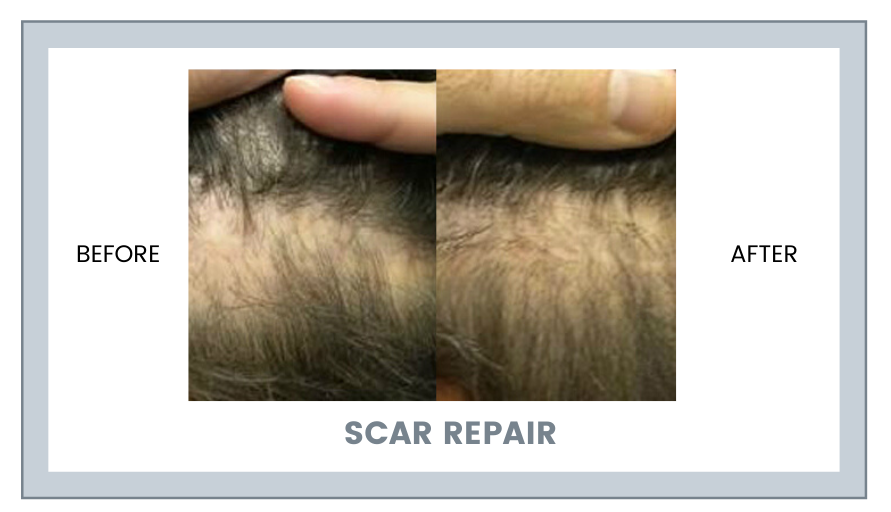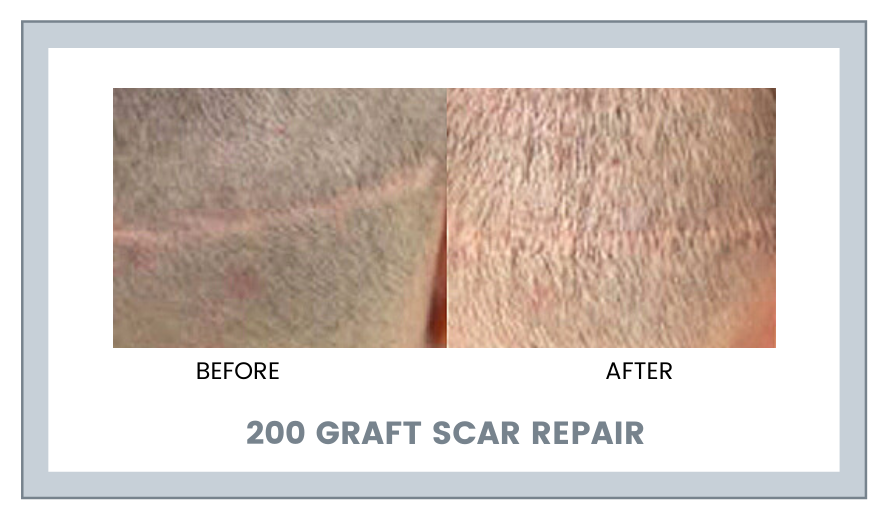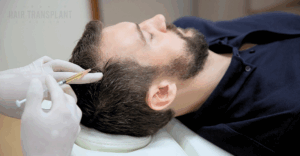Scar Removal: Hair Transplant Options for Scar Reduction – Toronto Hair Transplant Surgeons
At the Toronto Hair Transplant Surgeons, we’ve come across a fair number of patients who are looking for help to reduce scarring from hair replacement surgeries conducted at other clinics.
It’s important to understand that the outcome of the first surgery is crucial, as grafts from the initial procedure are permanent. If the first surgery is performed poorly, it can limit future hair restoration options and compromise the final result.
Most notably, patients who have undergone a FUT or strip procedure and have found themselves dissatisfied or self-conscious about the scar they were left with.
Finding a skilled surgeon to help with these repairs is important because this is not something you want to have to deal with repeatedly. The surgeon’s expertise directly impacts scar outcomes and the overall success of scar repair or revisions. Here’s what we want you to know about closure techniques we use and how we address scar repair or revisions.
Introduction to Hair Transplant Scars
Hair transplant scars are a common concern for anyone considering or having undergone hair transplantation. While the primary goal of hair restoration is to achieve a natural-looking hairline and a fuller appearance, the reality is that some degree of scarring can occur. The type and visibility of hair transplant scars often depend on the surgical technique used. For example, Follicular Unit Transplantation (FUT) typically results in a linear scar at the donor site, as a strip of scalp is removed from the donor area, making scarring more noticeable. Follicular Unit Extraction (FUE), on the other hand, leaves behind tiny dot-like scars scattered across the scalp. Factors such as the patient’s scalp characteristics, the skill of the surgeon, and the method of closure all play a role in how noticeable these scars become. Fortunately, advancements in hair transplant procedures, including the use of laser therapy and scalp micropigmentation, have made it possible to minimize scarring and improve overall results. Understanding the different types of scars and the options available for scar reduction is the first step toward achieving a more natural and confident look.
TRICHOPHYTIC CLOSURE WORKS WELL WITH STRIP INCISION HAIR TRANSPLANTS
For strip incision hair transplants, the use of trichophytic closure minimizes the appearance of a scar in the donor area. This is done by cutting off the top of one wound edge and suturing it so that the hair from that edge grows through the scar. Either wound edge can be trimmed in the technique, but removing part of the upper edge is most common.
FUT scars typically appear as a linear scar line in the donor area. However, advanced closure techniques can help minimize the visibility of the scar line and improve the overall result.
Our very own Dr Jones used this technique for his own hair transplant with incredible results. He added this entry to his Blog on August 1, 2006:
Trichophytic closure works!! Hair growing in my scar!
When a strip of hair is taken from a donor area in order to be transplanted in areas of thinning or non-existent hair, a fine linear scar may remain. Surgeons minimize the risk of a visible scar in various ways. Trichophytic Closure is a way of closing the wound of the donor area that causes hair to grow in that area by suturing the wound edge to the scar.
Proper spacing of hair follicles during closure is essential for achieving a natural appearance and better concealment of the scar line.
SCAR REPAIR HAIR RESTORATION TECHNIQUE
Depending on the type of hair restoration technique performed, the physician’s experience, and the amount of tissue removed, scar results will vary. Follicular unit transplant (FUT) and follicular unit excision (FUE) are the two main methods: FUT typically results in linear scars, which can be more noticeable, especially in younger patients or those with shorter hair, while FUE leaves small, round scars that are generally less visible and more suitable for scar coverage. Some scars are small and easy to hide, while others may be in need of additional scar repair. Longer hair can help conceal FUT scars, whereas shorter hair may make linear scars more visible. The appearance of scars also depends on the condition of the recipient area and the quality of the scarred skin, as well as the amount of existing hair and the degree of thinning hair present.
After multiple procedures, wide or visible scars can become unsightly, needing either revision or planting with follicular unit excision (FUE). Hair transplant scar revision is an effective treatment for visible scars, and treatment depends on factors such as scar thickness, skin type, the presence of existing hair, and the health of the scalp area. Keloid scars, in particular, can pose challenges for hair transplants as they might grow larger due to the procedure. The number of hairs and hair grafts available for transplantation, as well as the surgeon’s expertise in harvesting hair follicles and achieving proper spacing of follicular units, play a crucial role in minimizing noticeable scarring and achieving natural-looking results.
In terms of technique, strip incisions (FUT) leave recognizably different linear scars on the scalp, while follicular unit excision (FUE) leaves 1mm, round-shaped scars around the donor areas. FUE scars are typically less visible and can result in minimal scarring, especially when performed by an experienced surgeon. These small, round scars can appear as tiny white dots when healed, making them less noticeable than FUT scars. Linear scars from FUT procedures can be more noticeable, particularly in younger patients or those with shorter hair. The appearance of scars also depends on the condition of the recipient area and the quality of the scarred skin. Maintaining healthy skin is important for optimal healing and transplanted hair growth. The healing process is gradual as the scar forms and matures over time, and the timing of hair transplant surgery on scar tissue—usually waiting 6 to 12 months for the scar to fully develop—is important for optimal results. More hair or scalp micropigmentation can be used to create the appearance of increased density and better scar camouflage.
There are two methods of scar repair used on patients: scar revision with suture and placement of follicular unit excision into the scar. FUE is often preferred for scar coverage due to its precision and minimal scarring compared to FUT. This technique allows for better camouflage of scars and can significantly improve the overall appearance of the treated area.
- Scar Revision with Suture
This is a method of scar repair that involves improving the appearance of the scar. If there is not too much tension on the scar, an attempt can be made at excising the scar and resuturing it. Every effort must be made to minimize any tension on the scar as “stretch back” or reopening will occur.
Generally, there is a 90% chance that the scar will improve with scar revision. Other possibilities include a 9% chance that the scar will remain the same and a small 1% chance that the scar will be worse.
- Placement of FUE Into Scar
This has become a very popular means of scar repair. It involves removing or harvesting individual hair follicles or hair grafts from the body or head and grafting them into the scar tissue at the back of the head. This technique improves scar camouflage and helps achieve a more natural look. Usually, 50% to 90% of the grafts grow in scars, making the scarred areas of the scalp much less visible. The success of grafting hair follicles into scars depends on the health of the scalp area and the ability to harvest hair follicles from the donor region. Maintaining healthy skin is essential for optimal healing and growth of transplanted hair.
Scar Repair Using ACell
A biotechnology company called ACell has created a product that regenerates the skin of scars with normal hair follicles. The product is a basement membrane that allows for epithelial cell growth, or more simply skin regeneration. The raw concept is to stimulate the bodies’ natural processes to re-grow damaged skin. The idea is that since this regeneration is natural it won’t be rejected by the body. They also wanted it to be absorbable so there’s no trace and completely natural to the patient’s body. The success of skin regeneration with ACell can be influenced by factors such as blood vessels in the scalp, which are essential for delivering nutrients and supporting healing.
ACell is a product that has been used in Veterinary medicine for years. It caught the interest of our doctors because it not only regenerates skin but regenerates skin with normal hair follicles. Further, Acell has been approved for wound care in humans, and in patients where it has been used, the hair follicles regenerate as well as the skin. Individual skin type can affect the appearance and pigmentation of regenerated skin and the overall outcome of scar repair.
For some additional insight into our work here are the Toronto Hair Transplant Surgeons, please see some of our before and after photos below or visit our gallery for more examples of our work:
Non-Surgical Alternatives for Scar Reduction
For those seeking to reduce the appearance of hair transplant scars without additional surgery, several non-surgical alternatives are available. Laser hair removal can be used to target and remove unwanted hair around the scar area, helping to blend the scar with the surrounding scalp and make it less noticeable. Scalp micropigmentation is another effective option, where specialized pigments are applied to the scalp to mimic the look of natural hair follicles, camouflaging both linear and dot-like scars. Gentle massage and attentive wound care can also play a role in scar reduction by promoting healthy blood flow and reducing the risk of developing keloid scars. These non-surgical methods can be used alone or in combination with surgical treatments to enhance results. Consulting with a qualified professional is essential to determine which approach is best suited to your specific hair transplant scar and overall goals.
Book a Consultation
If you’re concerned about hair transplant scars or are interested in exploring your hair restoration options, scheduling a consultation with a skilled surgeon is the best place to start. During your consultation, you’ll have the opportunity to discuss your unique concerns, review the different hair transplant procedures available, and receive a personalized treatment plan tailored to your needs. Following post-treatment aftercare instructions is crucial for achieving optimal results after a hair transplant. A thorough assessment of your hair loss, scalp condition, and medical history will help your surgeon recommend the most effective solutions for minimizing scars and restoring your hair. Don’t let concerns about scarring prevent you from achieving the look you want—reach out to us today to book your consultation and take the first step toward renewed confidence and a fuller head of hair.
Conclusion
Hair transplant scars can be a significant concern for many individuals considering or recovering from hair transplantation. However, thanks to ongoing advancements in technology and surgical techniques, it is now possible to minimize scarring and achieve a natural, seamless hairline. By understanding the different types of hair transplant scars and the available treatment options, you can make informed decisions about your hair restoration journey. Whether you choose surgical or non-surgical alternatives, working with a skilled surgeon is key to achieving the best possible results. With the right approach, you can reduce the appearance of hair transplant scars and enjoy a fuller, more confident you. Remember, every journey to hair restoration begins with a single step—schedule your consultation today and discover the possibilities for a healthier, more vibrant scalp.
For some additional insight into our work here are the Toronto Hair Transplant Surgeons, please see some of our before and after photos below or visit our gallery for more examples of our work:







